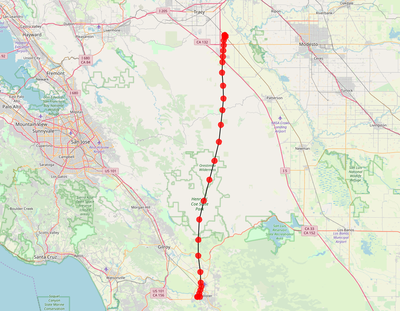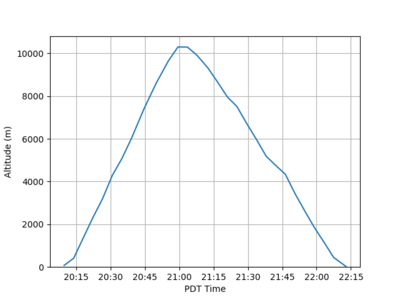Difference between revisions of "SSI-92"
m |
m |
||
| Line 16: | Line 16: | ||
}} | }} | ||
| − | '''SSI-92''' (project designation '''CY-6''') was the sixth launch of [[Cycloon|Project Cycloon]] on October 5, 2019. It was the first interstate Cycloon flight, the first launch of a poly tubing ZPB, and the first ZPB flight for which telemetry at equilibrium and descent was acquired since [[SSI-20]]. This enabled the acquisition of valuable thermal data and verification of equilibrium altitude predictions. | + | '''SSI-92''' (project designation '''CY-6''') was the sixth launch of [[Cycloon|Project Cycloon]] on October 5, 2019. It was the first interstate Cycloon flight, the first launch of a poly tubing ZPB, and the first ZPB flight for which telemetry at equilibrium and descent was acquired since [[SSI-20]]. This enabled the acquisition of valuable thermal data and verification of equilibrium altitude predictions. Continuing a trend, the payload was lighter still than that of its predecessor, [[SSI-91]]. |
==Project context== | ==Project context== | ||
| Line 22: | Line 22: | ||
[[SSI-91]] was a milestone in realizing flights with in-house manufactured ZPBs, yet due to unexpected termination no data on the equilibrium altitude and descent characteristics were obtained, thus failing to fulfill one of the major objectives of that flight. Meanwhile, a candid assessment of the ZPB manufacturing process proved discouraging. In mid to late August, a new manufacturing technique was devised based on commercially available polyethylene tubing, which promised to be far more durable and scalable. (The altitude limitations were deemed acceptable for the time being). Orders for commercial tubing were placed, set to arrive in September. In light of these developments, a third summer ZPB launch which had been planned for the weekend of September 1 was cancelled. | [[SSI-91]] was a milestone in realizing flights with in-house manufactured ZPBs, yet due to unexpected termination no data on the equilibrium altitude and descent characteristics were obtained, thus failing to fulfill one of the major objectives of that flight. Meanwhile, a candid assessment of the ZPB manufacturing process proved discouraging. In mid to late August, a new manufacturing technique was devised based on commercially available polyethylene tubing, which promised to be far more durable and scalable. (The altitude limitations were deemed acceptable for the time being). Orders for commercial tubing were placed, set to arrive in September. In light of these developments, a third summer ZPB launch which had been planned for the weekend of September 1 was cancelled. | ||
| − | With the end of the summer, onboarding approached, and it was hoped to do a Cycloon demonstration launch very near the beginning of the year, on '''October 5, 2019'''. Ideally this would be ballast-controlled, collecting data and paving the way for a fully controlled launch in the middle of the quarter. It was also hoped to do this launch from Pigeon Point, but by September 23, wind forecasts proved unfavorable. Additionally, momentarily it was planned to launch two ballast controlled balloons (as a means of forcing Cycloon to self-manufacture a ballast mechanism), but as 3D printing attempts in the last week of September failed, | + | With the end of the summer, onboarding approached, and it was hoped to do a Cycloon demonstration launch very near the beginning of the year, on '''October 5, 2019'''. Ideally this would be ballast-controlled, collecting data and paving the way for a fully controlled launch in the middle of the quarter. It was also hoped to do this launch from Pigeon Point, but by September 23, wind forecasts proved unfavorable. Additionally, momentarily it was planned to launch two ballast controlled balloons (as a means of forcing Cycloon to self-manufacture a ballast mechanism), but as 3D printing attempts in the last week of September failed, it was decided to fly only one standard (non-controlled) ZPB. Nevertheless, a significant worksession on September 29 produced two balloons and two sets of avionics (one new, one recovered from [[SSI-91]]. |
| − | Relatively | + | Relatively close to the day of the launch, demands for an improved cutdown mechanism intensified. Amidst an absence of nichrome, a novel cutdown mechanism involving two ematches and a socket was devised, implemented, and tested the night of October 4. |
==Configuration== | ==Configuration== | ||
| − | '''Balloon''': 0. | + | '''Balloon''': 0.8 mil polyethylene tubing, paper bag topology, width 2.5 m, length 10 m, volume approximately 17.5 cubic meters. Total mass 1 kg with fill tube (PVC of length approximately 12 inches and diameter 1/2 inch). |
| − | '''Avionics''': TinyGPS, Teensy 3.2 transmitting at adjustable intervals over Rockblock. SPOT Trace | + | '''Avionics''': TinyGPS, Teensy 3.2, BMP 280 transmitting at adjustable intervals over Rockblock. A SPOT Trace was accidentally omitted. This set of avionics was recovered [[SSI-91|CY-5]]. Controlled novel cutdown mechanism. |
| − | '''Power''': 9 L91 lithium AA batteries. | + | '''Power''': 9 L91 lithium AA batteries. 3 L91 lithium AA batteries on cutdown. |
| − | '''Payload''': Styrofoam enclosure. Mass 0. | + | '''Payload''': Styrofoam enclosure. Mass 0.55 kg |
| − | '''Mass budget''': | + | '''Mass budget''': 1.57 kg total. |
==Flight synopsis== | ==Flight synopsis== | ||
Revision as of 07:47, 6 December 2019
| SSI-82 | ||||
|---|---|---|---|---|
| Designations | CY-6 | |||
| Launch date | October 5, 2019, 11:00 PDT | |||
| Launch site | Brigantino Park, Hollister, CA | |||
| Launch coordinates | 36.849, -121.433 | |||
| Flight duration | 9h:28m | |||
| Flight profile | Standard zero pressure | |||
| Landing time | October 5, 2019, 20:38 PDT | |||
| Landing site | 16 km SSW of Alamo, Lincoln County, NV | |||
| Landing coordinates | 37.144, -115.262 | |||
| ||||
SSI-92 (project designation CY-6) was the sixth launch of Project Cycloon on October 5, 2019. It was the first interstate Cycloon flight, the first launch of a poly tubing ZPB, and the first ZPB flight for which telemetry at equilibrium and descent was acquired since SSI-20. This enabled the acquisition of valuable thermal data and verification of equilibrium altitude predictions. Continuing a trend, the payload was lighter still than that of its predecessor, SSI-91.
Project context
SSI-91 was a milestone in realizing flights with in-house manufactured ZPBs, yet due to unexpected termination no data on the equilibrium altitude and descent characteristics were obtained, thus failing to fulfill one of the major objectives of that flight. Meanwhile, a candid assessment of the ZPB manufacturing process proved discouraging. In mid to late August, a new manufacturing technique was devised based on commercially available polyethylene tubing, which promised to be far more durable and scalable. (The altitude limitations were deemed acceptable for the time being). Orders for commercial tubing were placed, set to arrive in September. In light of these developments, a third summer ZPB launch which had been planned for the weekend of September 1 was cancelled.
With the end of the summer, onboarding approached, and it was hoped to do a Cycloon demonstration launch very near the beginning of the year, on October 5, 2019. Ideally this would be ballast-controlled, collecting data and paving the way for a fully controlled launch in the middle of the quarter. It was also hoped to do this launch from Pigeon Point, but by September 23, wind forecasts proved unfavorable. Additionally, momentarily it was planned to launch two ballast controlled balloons (as a means of forcing Cycloon to self-manufacture a ballast mechanism), but as 3D printing attempts in the last week of September failed, it was decided to fly only one standard (non-controlled) ZPB. Nevertheless, a significant worksession on September 29 produced two balloons and two sets of avionics (one new, one recovered from SSI-91.
Relatively close to the day of the launch, demands for an improved cutdown mechanism intensified. Amidst an absence of nichrome, a novel cutdown mechanism involving two ematches and a socket was devised, implemented, and tested the night of October 4.
Configuration
Balloon: 0.8 mil polyethylene tubing, paper bag topology, width 2.5 m, length 10 m, volume approximately 17.5 cubic meters. Total mass 1 kg with fill tube (PVC of length approximately 12 inches and diameter 1/2 inch).
Avionics: TinyGPS, Teensy 3.2, BMP 280 transmitting at adjustable intervals over Rockblock. A SPOT Trace was accidentally omitted. This set of avionics was recovered CY-5. Controlled novel cutdown mechanism.
Power: 9 L91 lithium AA batteries. 3 L91 lithium AA batteries on cutdown.
Payload: Styrofoam enclosure. Mass 0.55 kg
Mass budget: 1.57 kg total.
Flight synopsis
Inflation was eventful thanks to strong ground winds from due west. The envelope ruptured midway through filling and was patched before refilling. Additionally, a hole approximately 5 mm in diameter was patched.
August 5 2011 PDT: Balloon released from a running start. Initial motion to the east at an ascent rate of 3.8 m/s --- significantly faster than the target ascent rate of 2.5 m/s.
August 5 2059 PDT: After almost an hour of steady ascent, balloon reaches a maximum altitude of 10.298 km over (37.1502, -121.4077). Ascent rate had fluctuated above and below the initial rate of 3.8 m/s. In theory, a slight acceleration in ascent was expected. By this time the balloon was in the jet stream layer travelling north at nearly 30 m/s.
August 5 2103 PDT: Balloon reported an altitude of 10.291 km, a highly unexpected measurement. In retrospect, it is believed that venting began at this altitude, but the vent hole was far too small to vent the necessary volume, leading to envelope rupture. The resulting leakage prevented the balloon from reaching the calculated equilibrium altitude of 14-15km and caused what more resembles a latex profile than a zero-pressure balloon profile.
August 5 2055 PDT: Balloon reported first definitive descent at an altitude of 9.905 km.
August 5 2213 PDT: After an hour of descent at 2.5 m/s - 3.0 m/s, balloon reported a ground elevation of 29 km. The landing site was less than 100 m from a road in an apple orchard.
August 9 0316 PDT: Last RockBlock transmission received, with no indication of movement since flight termination.
| Balloon Launches | |
|---|---|
| 2014-15 | SSI-19 • 20 • 21 • 22 |
| 2015-16 | SSI-23(a) • 24 • 25 • 26 • 27 • 28 • 29 • 30 • 31 • 32 • 33 • 34 • 35 • 36 • 37 • 38 • 39 • 40 • 41 • 42 • 43 |
| 2016-17 | 44 • 45 • 46 • 47 • 48 • 49 • 50 • 51 • 52 |
| 2017-18 | |
| 2018-19 | 83 • 86 • 87 • 90 • 91 |
| 2019-20 | 92 • 93 • 97 |
| V • E | |


